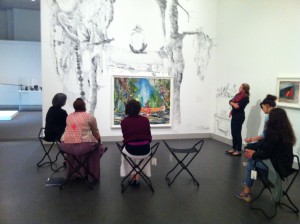
Practicing VTS in the Contemporary Art Galleries at the Brooklyn Museum
On Thursday and Friday of last week, I participated in the Visual Thinking Strategies Practicum at the Brooklyn Museum. Although museum educators talk a lot about VTS, “modified VTS,” and the benefits and challenges of working with VTS in the galleries, I realized that I had never had an opportunity to practice pure VTS and truly internalize the theory behind the practice. I used the practicum as an opportunity to delve into VTS without worrying about the expectations of classroom teachers or making curricular connections. My major takeaways from this experience are:
- After participating in about 12-13 VTS sessions in two days, led by both VTS facilitators and fellow participants, I found myself immersed in the rhythm of VTS. Since VTS involves only 3 basic questions (What is going on in this picture? What do you see that makes you say that? What more can we find?), I found that I was able to listen more to the comments and observations of the group since I was not worried about hearing the next questions from the facilitator and thinking of the correct answer – I already knew what the next question would be! The repetition was not tedious since each work of art elicited different comments, observations, and discussion. Since I try to begin every class I teach during a TTA residency with looking at a work of art, I realize how useful it could be to use VTS to help students know what to expect every time a Rubin educator comes to their class.
- VTS is seemingly simple but tricky for people to understand. Our homework after the first day was to explain VTS to someone not familiar with it. In our discussion of the assignment, I was struck with how some people related VTS skills to skills needed in other unrelated fields, including public radio interviewing, improv comedy, and medical diagnosis. This confirmed to me that not only do people understand the world according what they know and are comfortable with, but also that facilitating and participating in VTS teaches skills and habits (such as listening, being present, staying neutral, observing, etc) that are transferable to other areas.
- After all this, my last takeaway is that I still like getting the information about a work of art. Even after the most satisfying VTS discussion, I found myself looking at the label to place the painting in a larger art historical context and to see if what we observed as a group was “correct.” In my own gallery practice, I know that I will have to make curricular connections and that I will have to meet expectations of teachers and students who, like me, want to know facts and stories. I feel that I am more comfortable with the questioning, paraphrasing, and pointing that goes into facilitating a VTS session. I hope that I will have more opportunities to use VTS in its pure form and I know that the skills that I practiced during these two days will definitely transfer to my regular gallery practice.

Selecting images for VTS discussion.


